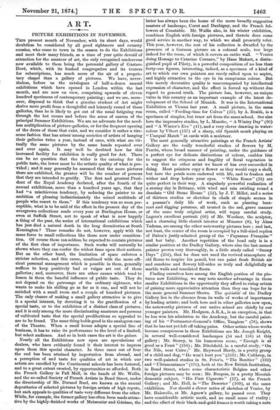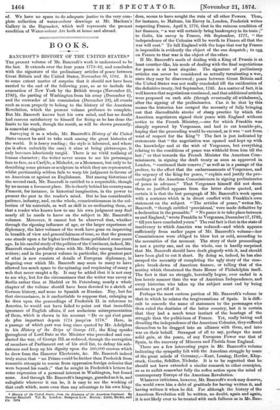ART.
PICTURE EXHIBITIONS IN NOVEMBER. Tars present month of November, with its short days, would doubtless be considered by all good sightseers and country cousins, who come to town in the season to do the Exhibitions and meet their many friends, as a time of year quite devoid of attraction for the amateur of art, the only recognised rendezvous now available to them being the perennial gallery of Gustave Dore, which, with its hushed congregation and its touters
for subscriptions, has much more of the air of a proprie- tary chapel than a gallery of pictures. We have, never- theless, before us the catalogues of half-a-dozen annual exhibitions which have opened in London within the last month, and are now on view, comprising upwards of eleven hundred specimens of contemporary painting ; and we are, more- ever, disposed to think that a genuine student of Art might derive more profit from a thoughtful and leisurely round of these galleries, than he is likely to get out of the usual fatiguing ran 'through the hot rooms and before the acres of canvas of the principal Summer Exhibitions. We are no advocate for the need- les; multiplication of picture-galleries, or for the frequent opening of the doors of those that exist, and we consider it rather a tire- some fashion that has arisen-among societies of artists of hanging their galleries twice a year, instead of once, with what are vir- tually the same pictures by the same hands repeated over and over again. It may well be doubted how far this increased facility for exhibition is really good for Art. There can be no question that the wider is the catering for the public taste, the lower must be the artistic quality of what is pro- -Tided; and it may generally be assumed that the more pictures there are exhibited, the greater will be the number of persons that they are intended to gratify. The first and greatest Presi- dent of the Royal Academy declared, after the fourth of its annual exhibitions, more than a hundred years ago, that they had "a mischievous tendency, by seducing the painter to an -ambition of pleasing indiscriminately the mixed multitude of people who resort to them." If this tendency was so soon per- ceptible, what is to be said of the effect in the present day of the overgrown collections made every year at Burlington House, or even at Suffolk Street, not to speak of what is now happily a thing of the past, the series of international exhibitions which has just died a natural death in the long dormitories at South Kensington ? These remarks do not, however, apply with the -same force to small collections like those now under considera- tion. Of course these can seldom be expected to contain pictures of the first class of importance. Such works will naturally be shown where they can confer the widest fame upon their authors. But on the other hand, the limitation of space enforces a stricter selection, and this cause, combined with the more effi- cient personal management which is possible in them, generally suffices to keep positively bad or vulgar art out of these galleries ; and, moreover, there are other causes which tend to lessen in them the baneful influence of public taste. They do not depend on the patronage of the ordinary sightseer, who wants to make his shilling go as far as it can, and will not be satisfied with a small room and a couple of hundred pictures. The only chance of making a small gallery attractive is to give it a special interest, by devoting it to the gratification of a special taste, or to the exhibition of a distinct class of pictures, -and it is only among the more disciminating amateurs and persons of cultivated taste that the special predilections so appealed to are to be found. The same thing holds good in the analogous case of the Theatre. When a small house adopts a special line of business, it has to raise its performance to the level of a limited, but select audience. And so in both cases the art is the gainer.
Nearly all the Exhibitions now open are speculations of dealers, who have evidently found it their interest to impress upon them this special character. In three cases out of four -the end has been attained by importation from abroad, and a perception of and taste for qualities of art in which our artists are excelled by the Continental schools has been fostered, and to a great extent created, by opportunities so afforded. Both the French Gallery in Pall Mall, in the hands of Mr. Wallis, and the so-called Society of French Artists in Bond Street, under the directorship of Mr. Durand Ruel, are known is the annual depositaries of selected pictures by foreign artists of high repute, but each appeals to qualities of taste very different from the other. While, for example, the former gallery has often been made attrac- tive by the highly-finished works of Meissonier and Gerdme, the latter has always been the home of the more broadly suggestive masters of landscape, Corot and Daubigny, and the French fol- lowers of Constable. Mr. Wallis also, in his winter exhibition, combines English with foreign pictures, and therein does some good service in another way, to which we shall presently refer. This year, however, the rest of his collection is dwarfed by the presence of a German picture on a colossal scale, too large indeed for the room, of which it covers an entire wall. "Venice doing Homage to Catarina Cornaro," by Hans Makart, a distin- guished pupil of Piloty, is a powerful composition of no less than forty-one figures, interesting, indeed, as a specimen of a kind of art to which our own painters are rarely called upon to aspire, and highly attractive to the eye in its sumptuous colour. But this merely decorative quality is unaccompanied by intellectual expression of character, and the effect is forced up without due regard to general truth. The picture has, however, an unique value in this country as an important example of the latest de- velopment of the School of Munich. It was in the International Exhibition at Vienna last year. A small picture, in the same room, called "Feeding-time for Calves" (25), by A. Braith, is a specimen of simpler, but truer art from the same schooL See also here the impressive studies, by L. Munthe, "A Wintry Day" (80) and "A Winter's Eve" (41), and a very clever drawing in water- colour by Vibert (137) of a sharp, old Spanish monk playing an "Unequal Match" at cards with a muleteer.
The most generally attractive paintings at the French Artists' Gallery are the really wonderful studies of flowers by M. Fantin, whose broad manner of painting, under the guidance of a perfect eye for delicate distinctions of colour, enables him to suggest the crispness and fragility of floral vegetation in a way that no other artist we know of has ever succeeded in doing. Most painters copy a flower as they would copy a shell, but here the petals seem endowed with life, and to freshen and wither and drop before your eyes. "White Roses" (25) are quite perfect in their way. A singularly powerful realisation of a stormy day in Brittany, with wind and rain swirling round a desolate "Old Stone House" (52), by J. F. Millet, and a series of thirteen studies or sketches in chalk of simple scenes in a peasant's daily life of work, such as planting beet- root and digging potatoes, all treated in the sad, grave manner of the same truly original artist, will repay careful study. Legros's excellent portrait (66) of Mr. Woolner, the sculptor, and a charming little church interior at Miinater (8), by Alma Tadema, are among the other noteworthy pictures here ; and last, not least, the centre of the room is occupied by a full-sized replica of Dalou's justly-admired group of the " Paysanne Fransaise " and her baby. Another repetition of the head only is in a similar position at the Dudley Gallery, where also the last-named painter proves very thoroughly, in a little study called "Sunny Days" (251), that he does not need the revived atmosphere of old Rome to inspire his pencil, but can paint fresh British air and sunshine and flowery hill-sides as truly and delightfully as marble walls and tesselated floors.
Finding ourselves here among the English portion of the pic- tures now Exhibiting, we may note another advantage in these smaller Exhibitions in the opportunity they afford to rising artists of gaining more appreciative attention than they can hope for in the more general Summer Shows. The spkialite of the Dudley Gallery lies in the absence from its walla of works of importance by leading artists; and both here and in other galleries now open, the noteworthy pictures of our native school are chiefly by our younger painters. Mr. Hodgson, A.R.A., is an exception, in that he has won his admission to the Academy, but the careful paint- ing of his "Postmaster-General's Office, Tangiers" (76), shows that he has not yet left off taking pains. Other artists whose works become conspicuous in these Exhibitions are Mr. Joseph Knight, in several well-considered landscapes (54 and 158) at thii2 gallery ; Mr. Storey, in his humorous scene, "Enough is as good as a Feast" (216) ; Mr. Ditchfield, in a careful study, "On the Nile, near Cairo ;" Mr. Heywood Hardy, in a pretty group of a child and dog, "He won't hurt you" (259) ; Mr. Calthrop, in two well-painted studies in St. Peter's, "The Benitier " (132) and " Ultramontanes " (170), both at the New British Institution, in Bond Street, where some characteristic Belgian and other foreign pictures may be seen ; Mr. Burgess, in a pretty Moorish domestic subject, "His First Cigarette" (17), at the French Gallery; and Mr. Roll, in "The Deserter" (109), at the same exhibition. Nor should a clever aeries of sketches of Venice, by Mr. Ilalswelle, at Mr. Agnew's gallery, be passed over. They have considerable artistic merit, and no small sense of reality ; and the effect of their black-and-gold frames is worth taking a note of. We have no space to do adequate justice to the very com- plete collection of water-colour drawings at Mr. Maclean's Gallery in the Haymaket, which well represents the present condition of Water-colour Art both at home and abroad.



































 Previous page
Previous page